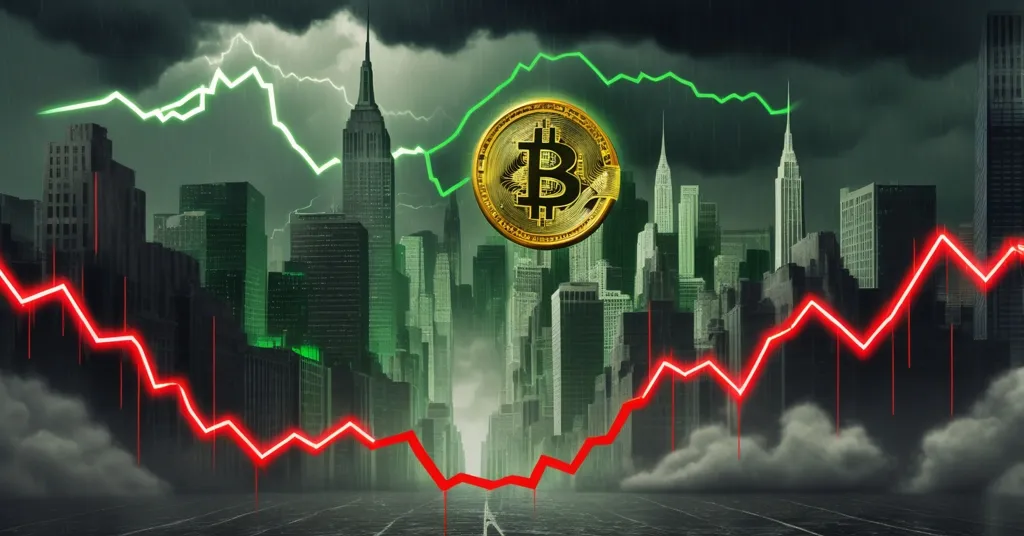S&P 500 Rally Stumbles: Bitcoin and Crypto Markets Brace for Impact

S&P 500 Rally Faces Headwinds: Bitcoin and Crypto Markets in the Crosshairs
The S&P 500 has powered through a staggering 28% rally over the past 75 trading days, echoing the ferocious rebound of 2020’s pandemic recovery. But as August and September loom—months notorious for dragging stocks down—could this traditional market stumble shake up Bitcoin and the broader crypto space, or will it pave the way for decentralized assets to steal the spotlight?
- Stock Surge at Risk: S&P 500’s 28% gain braces for a historically weak late summer.
- Fed’s Big Moment: Jerome Powell’s interest rate update could spark market chaos.
- Crypto’s Double-Edged Sword: Traditional downturns might fuel or fracture digital asset adoption.
Let’s slice through the hype and get down to brass tacks. The S&P 500’s recent tear, as flagged by JPMorgan Asset Management, is a beast—28% in just 75 days, a run that screams post-stimulus optimism and investor bravado. It’s a hell of a performance, nearly matching the post-COVID sugar rush. But here’s the kicker: history shows no mercy in late summer. Over the past 30 years, August and September have averaged a 0.7% drop for the index, a gut punch compared to the 1.1% monthly gains seen in other stretches. What’s behind this slump? It’s a perfect storm of institutional chess moves—mutual funds offloading losers for tax breaks, corporations locking down budgets as fiscal years wrap—and retail investors getting the jitters, dialing back on risk. A fresh survey from the National Association of Active Investment Managers shows U.S. stock allocations at their lowest since late May, painting a picture of nerves on edge. For more on this trend, check out the detailed analysis of S&P 500’s historic rally facing challenges.
Now, throw in the heavyweight wildcard: the Federal Reserve. For the uninitiated, the Fed is the U.S. central bank, pulling the strings on monetary policy by tweaking interest rates. These decisions ripple everywhere—higher rates jack up borrowing costs, nudging money into “safe” bets like bonds, while lower rates often flood riskier assets like stocks or Bitcoin with cash. This Wednesday, Fed Chair Jerome Powell is set to drop a bombshell update on rates, and the market’s holding its breath. For a deeper look at how these policies impact digital assets, see this discussion on Federal Reserve rate effects on cryptocurrency markets. Ed Clissold, Chief U.S. Strategist at Ned Davis Research, didn’t sugarcoat it:
“If Powell signals no rate cuts are coming for the foreseeable future, traders will be disappointed, and it may fuel a brief selloff.”
That kind of letdown could hammer Wall Street, especially with commodity trading advisers sitting on equity positions in the 94th percentile—the most bullish since January 2020. If the mood sours, expect a stampede for the exits and volatility to spike. On the other hand, a dovish signal—meaning a tilt toward lower rates to juice the economy—might prop up stocks, though seasonal drag could still kneecap any rally. Curious about community reactions to such Fed decisions? Take a peek at this thread on Bitcoin price reactions to Federal Reserve moves.
Meanwhile, there’s a side plot in traditional finance worth a squint: long-short hedge funds are clawing their way back. After bleeding $120 billion in redemptions since 2016, these funds—which bet on some stocks climbing and others cratering—sucked in $10 billion in the first half of 2025. Powerhouses like Maverick (up 14%), D1 Capital Partners (a meaty 20%), and SurgoCap Partners (17% this year after a 33% haul in 2024) are reaping rewards, capitalizing on market turbulence and higher rates to cherry-pick winners. This drift from passive index-tracking to active hunting for “alpha” (beating the market average) hints at a broader itch for outperformance in choppy seas. And here’s where crypto enters the frame—volatility is the name of the game in digital assets, a sandbox where active strategies could explode if big money pivots to decentralized plays.
Geopolitical Firestorm: A Crypto Catalyst?
Let’s not ignore the geopolitical dumpster fire fanning the flames. Trump’s 2025 tariff agenda, with duties as high as 200% on certain imports, is rattling global supply chains and spiking commodity prices—copper’s already jumped 30% on the London Metal Exchange. This kind of protectionist chest-thumping has a track record of unsettling markets, as we saw in past trade spats during Trump’s earlier tenure. For stock traders, it’s a migraine; for the crypto crowd, it’s raw opportunity. Bitcoin and other decentralized assets often glitter as hedges when fiat currencies waver or trade chaos erupts. Think of BTC as digital gold—a lifeboat when the dollar or global markets look like they’re sinking. With tariffs inflating costs and stoking uncertainty, some investors might just flip the bird to traditional systems and pile into crypto. Learn more about this dynamic in the analysis of Trump’s tariff plans and their impact on decentralized assets, and explore the broader context of Bitcoin as a hedge during geopolitical unrest.
Bitcoin’s Own Seasonal Blues and Market Ties
So where does this leave Bitcoin and the chaotic crypto frontier? First, a sobering parallel: Bitcoin historically slumps from May to September, clocking an average annualized drop of -17.61% over seven years, per Seasonax data. Ring a bell? That late-summer risk-off sentiment seems to plague both stocks and digital assets. If the S&P 500 trips as history suggests, and if Powell tightens the screws with higher rates, risk-laden assets like cryptocurrencies could take a beating as capital flees to safer ground. Numbers from CoinMetrics peg Bitcoin’s correlation with the S&P 500 at around 0.6 in recent years—when stocks catch a virus, BTC often needs a tissue too. We saw this play out in March 2020 when Bitcoin nosedived 39% alongside equities, only to rocket back later. For insights into these patterns, check out studies on seasonal downturns affecting crypto adoption, and watch this breakdown of S&P 500 seasonal trends impacting Bitcoin.
But let’s flip the script. Turmoil in traditional markets—be it seasonal, policy-driven, or sparked by tariff tantrums—can herd investors toward alternatives. Bitcoin, often crowned the ultimate hedge, could draw inflows as a store of value beyond the fiat circus. Ethereum, with its sprawling DeFi ecosystem (decentralized finance, aka banking without the middleman), might snag speculative interest, while stablecoins like USDT or USDC offer a smoother ride for the risk-shy. Trump’s recent pro-crypto noise, which has already nudged Bitcoin past $82,000 in market surges, tosses in some political wind at the back. If a crypto-friendly Congress or lighter regulatory touch takes shape, digital assets might just break free from stock market baggage and soar, even as Wall Street staggers. Over the long arc, as CoinLedger points out, lower rates and geopolitical mess tend to feed crypto’s underdog story. For a foundational understanding of Bitcoin’s market ties, refer to this comprehensive overview of Bitcoin and S&P 500 correlations.
The Ugly Underbelly: Crypto’s Hidden Risks
Before you go all-in on the “crypto saves the day” narrative, let’s slap some reality on the table. A stock market tumble could trigger liquidity crunches on exchanges, and whales—those big players who can swing prices with a single trade—might dump holdings to cover losses elsewhere, gutting Bitcoin or altcoin prices in a flash. Then there’s the regulatory specter. Governments rattled by capital dodging to decentralized corners could slam down the hammer with tighter rules or outright bans, especially if market stress amps up. We’ve seen those whispers before, and they’re not idle threats. And a quick PSA: don’t fall for the “Bitcoin to $500K by Christmas” garbage flooding X during volatile spikes. That’s shameless shilling, not insight, and we’ve got zero patience for scammers preying on hype. Adoption isn’t a neat fairy tale—it’s a brutal grind with plenty of pitfalls. For varied perspectives on Fed policies and crypto, browse this Q&A on Federal Reserve rate impacts on crypto markets.
Navigating the Storm: Tips for Crypto Players
Whether you’re a greenhorn stacking sats or a grizzled Bitcoin OG who’s seen it all, there’s strategy to chew on. Seasonal stock dips might be your cue to diversify into stablecoins for a breather or double down on Bitcoin’s bedrock fundamentals, not some flash-in-the-pan meme coin. Dollar-cost averaging—buying fixed chunks over time—can blunt the whiplash from Fed-driven swings. With tariffs stoking inflation fears, holding decentralized assets as a shield against currency erosion isn’t a crazy move either. Crypto isn’t just some quirky sideshow to Wall Street; it’s a parallel universe with its own rules, risks, and jaw-dropping potential for those who don’t flinch.
What’s on the Horizon?
Keep a laser focus on Powell’s wording this Wednesday—every word could jolt markets. Beyond that, Trump’s tariff rollout specifics and any crypto policy signals from Capitol Hill could tip the balance. Bitcoin’s price dance around key levels like $85,000 will also hint at whether it’s ready to ditch stock market coattails. Volatility? Guaranteed. Opportunity? Hell yes, for the sharp and the daring.
Key Takeaways and Questions for Crypto Enthusiasts
- How could Federal Reserve rate decisions rattle Bitcoin and crypto markets?
Higher rates or stalled cuts might spark risk aversion, siphoning capital from volatile crypto assets to safer havens, while a dovish Fed could ignite risk appetite and pump up Bitcoin or altcoin prices. - Can seasonal stock slumps drive cryptocurrency adoption?
Damn right—if the S&P 500 falters in August and September, some investors might flock to Bitcoin as a hedge or speculative bet, especially since crypto can march to its own beat during traditional market uncertainty. - What’s the fallout of geopolitical chaos like Trump’s tariffs on decentralized assets?
Trade disruptions and currency jitters from steep tariffs could spike interest in Bitcoin as a non-fiat refuge, framing crypto as a potential bunker amid global market storms. - Should crypto traders take cues from hedge fund tactics in volatile times?
You bet—the revival of active hedge fund strategies signals that hands-on analysis and timing could pay off in crypto too, rather than just riding out the waves with passive holding. - Are there dangers to crypto booming while stocks tank?
Hell yes—liquidity squeezes, regulatory smackdowns, and whale-driven price crashes could derail crypto’s safe-haven vibe, even if traditional markets hit the skids.
As the S&P 500 squares off against seasonal ghosts and Fed-fueled uncertainty, Bitcoin looms as both a shadow and a rogue to these forces. I’ll plant my flag with a Bitcoin maximalist tilt—BTC is the undisputed titan for dodging fiat insanity, though Ethereum’s DeFi wizardry and stablecoins’ steady hand carve out their own turf. Volatility is the game, but for those with steel nerves and a long view, the financial uprising marches on. Will Bitcoin finally snap free from Wall Street’s leash? Only the clock can call it.



